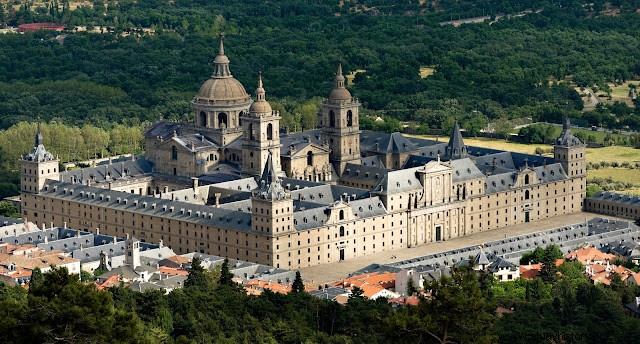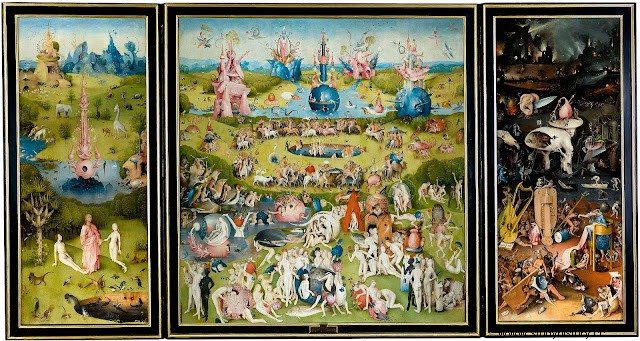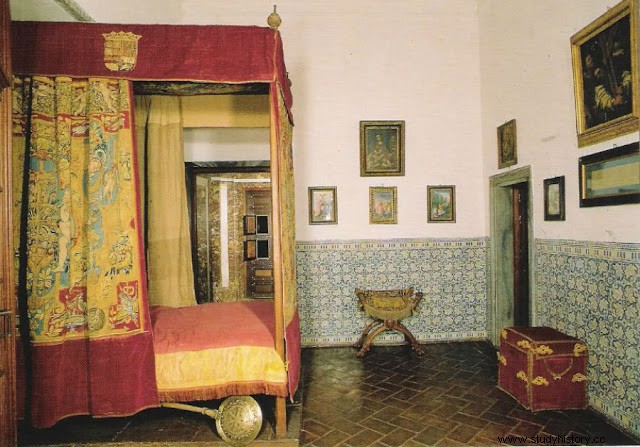"– And has the black dog appeared again? – I see and hear him everywhere, his barking wakes me up. spells so that it doesn't come back, it scares me"
Fascinated by his sarcastic and grotesque works, the "Wise King" was an obsessed collector of Bosch's works. So much so that he died in agony surrounded by them.
 Extraction of the stone of madness (El Bosco)
Extraction of the stone of madness (El Bosco) In the middle of the 16th century, in 1562 , Felipe II decides to build a monastery, a palace, a mausoleum, a library and a place of retirement, all in one, in a place located in the Sierra del Guadarrama. But in addition, with the construction of that building the king would fulfill a promise made by him after the victory against the French on the day of San Lorenzo, which is why he would dedicate his work to this saint. His interest in it was so great that a little more than twenty years later, in 1584, that palace-monastery was completely built.
But Philip II was not content with it. Established there, he decided that in that holy place, of deep mystical symbology, he would collect all the relics that were possible. And even more, he would buy, at whatever price, all those books and paintings with religious themes that would help him in his last wish:the encounter with God.
Due to his training and his vast culture, he always wanted to surround himself with the best artists and used a large amount of resources to patronage and promote art.
 El Escorial Monastery
El Escorial Monastery Among his court painters we find Alonso Sánchez Coello, Sofonisba Anguissola, Juan Pantoja de la Cruz and Juan Fernández de Navarrete. Apart from these authors who regularly worked for the monarch, we find purchased works by artists such as Memling, Dürer, Da Vinci, Michelangelo, Raphael, Correggio, Bassano, Sebastián del Piombo or Titian.
But really the painter who would accompany him until the end of his days was undoubtedly Jheronimus van Aken, popularly known as Bosch. He was a painter born in the north of the Duchy of Brabant, in what is now the Netherlands, author of an exceptional work both for the extraordinary inventiveness of his figurations and the subjects treated as well as for his technique, whom Erwin Panofsky described as an artist « distant and inaccessible» within the tradition of Flemish painting to which he belongs.

Bosco put his satirical vein at the service of a moral discourse based on the traditional doctrine of Catholic Church, with frequent allusions to sin, the transience of life and the madness of man who does not follow the example of the saints in his “imitation of Christ” . Ahead of his time, most of Bosch's works are impregnated with a pessimistic view of humanity, focused on the sins of human beings that are represented with great originality and a grotesque style that in the representation of figures is close to surrealism.
 Bosco
BoscoPhilip II was fascinated by "the diablerías" of Bosch. He filled the Monastery of El Escorial with all the paintings of El Bosco that he could. Most acquired them from other noble collections that existed at the time and once the Flemish artist had died. In 1574 came The Hay Wain, the Table of Deadly Sins, the Adoration of the Magi, Christ Carrying the Cross and several Temptations of Saint Anthony, while in 1593 other paintings arrived from the auction of Fernando de Toledo, son of the Grand Duke of Alba, such as The Garden of Earthly Delights or The Crowning with Thorns. Thanks to Philip II, Spain has the largest number of original works by Bosch.
Why this devotion to a strange painter who flaunted tastes apparently so contrary to those of our “prudent king”? They say that Bosch belonged to a secret, heretical society called the Adamites, a faction broken off from the Taborites. Of them it can be said that they were the first convinced nudists in history:they always prayed naked while waiting for the End of the World.
 The Garden of Earthly Delights, Bosch's most famous work, Prado Museum
The Garden of Earthly Delights, Bosch's most famous work, Prado MuseumThose paintings They were changing the personality of the king. Perhaps because of this hobby, or perhaps because of the intense pain of his illness, or because he was aware that his life was nearing its end, the king's mysticism became an obsession. In the midst of his agony due to his illnesses, those paintings were his best therapy. In them he tried to find relief from the suffering caused by his illness.
Since 1592 his health had irretrievably deteriorated. The drop was like a sharp knife that stabbed into his body, causing such intense pain that he couldn't even sign the documents that were placed before him. Neither sitting nor in bed, having to be his valet who devised a special chair that allowed the monarch to change position.
On June 30, 1561 he left Madrid never to return to the Cut. Like his father, who spent his last days in the Yuste monastery, he was now on his way to the El Escorial monastery. For six days he traveled in his special chair carried by porters who took turns. A journey that seemed eternal and endless. There he would await the arrival of death, the encounter with God. With his paintings that he had confiscated from his half-brother, Don Juan of Austria, after his victory in Flanders. Those paintings that spoke of sins, temptations and, above all, painted heaven and hell as if that Flemish painter had been in them.
 Room of Felipe II in El Escorial
Room of Felipe II in El EscorialThere is a fairly widespread legend that assures that when Felipe II was dying, he asked that all the Dutchman's paintings be brought to his room to strengthen himself morally. In his room was the table of the Table of Deadly Sins, which recalls what the sins of man are and in the corners glory and hell are represented.
The night of his death, September 13, 1598, the king woke up in the middle of a terrible nightmare. Father Sigüenza goes to his bed and the king shouts «the black dog and the man in black» . The father tries to reassure him, but he tells him that those came from the paintings that he hung on the walls of his bedroom. The presence of crucifixes and religious images in that room is easily justified. What was not so much is the presence of those paintings by Bosch, nine in total.
 The tunnel, painting by Bosch
The tunnel, painting by BoschSuffering pain so intense that he could not move, touch , wash or change clothes, at five in the morning on Sunday, September 13, 1598, Felipe II died in the monastery of El Escorial. He was 71 years old and his agony had lasted 53 days. According to legend, the king left this world contemplating The Garden of Earthly Delights, perhaps because there he saw the place that awaited him in eternity.
